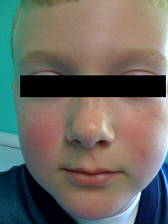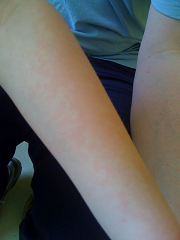In the Blink of an Eye: corneal abrasions
 Sand and specks of dried seaweed fly into the air. Your kids are on the beach shoveling their way to China. “Watch out!” you yell. “Watch those shovels! The ocean is big. The beach is big. You don’t need to be right on top of each other. There is plenty of sand for everyone.”
Sand and specks of dried seaweed fly into the air. Your kids are on the beach shoveling their way to China. “Watch out!” you yell. “Watch those shovels! The ocean is big. The beach is big. You don’t need to be right on top of each other. There is plenty of sand for everyone.”
You sigh and go back to counting snacks and unearthing buried flip-flops. You look back at the kids. Aw, you think to your self, they look so cute. Just as you reach for the camera, the idyllic moment is shattered. Your youngest is holding his eye and everyone, even the kid who threw sand into the injured child’s face, is crying.
Quickly you grab a water bottle and flush the irritating granules out of his eye. Satisfied nothing is left, you ask, “Does that feel better?” Your child ruefully nods, and resumes holding his eye. An hour later his eye is still watering. What next?
With any eye injury, pain, watery eyes or visual changes are all reasons to seek medical care. In this case, the sand or a little wood chip probably caused a scratch on the outer layer of the eye. This layer, called the cornea, heals very quickly. But like a scratch on any part of the body, the major potential complication is infection.
The most common way for health care providers to find a scratch on the cornea is to place a dye (fluorescine) into the injured eye. This dye glows under black light. The dye pools wherever there is a depression or scratch on the eye. Pictured here is a photo of a child I saw in the office the other day. The scratch is marked with an arrow. If an abrasion is found, your child’s doctor will prescribe antibiotic eye drops to prevent infection. Placing a patch over the eye has not been shown to hasten healing. However, for comfort, some children prefer putting on an eye patch for a day.
It’s a good thing our eyes are set back in our skulls, otherwise, we’d constantly have scratches on our eyes. Despite any precautions you may take, accidents still happen. Years ago a nurse I knew accidentally rolled over in bed and scratched her spouse’s eye with her diamond engagement ring. Imagine explaining that to the in-laws.
Naline Lai, MD with Julie Kardos, MD
© 2010 Two Peds in a Pod℠
 “Mom, can we do screen?”
“Mom, can we do screen?”

 Here is a photo of a lovely plant nestled along side the bicycle path my family rode on over the weekend. Recognize it? “Leaves of three, let them be!”- That’s right, it’s either poison oak or poison ivy. In this case my iphone captured poison ivy in its late spring glory. As we rode along I barked at my family to avoid the poison ivy, reminded them about Lyme ticks, rubbed in sunscreen, fitted bike helmets and fretted over everyone’s hydration status. Nothing is more jovial and carefree than a bike ride with your pediatrician mom!
Here is a photo of a lovely plant nestled along side the bicycle path my family rode on over the weekend. Recognize it? “Leaves of three, let them be!”- That’s right, it’s either poison oak or poison ivy. In this case my iphone captured poison ivy in its late spring glory. As we rode along I barked at my family to avoid the poison ivy, reminded them about Lyme ticks, rubbed in sunscreen, fitted bike helmets and fretted over everyone’s hydration status. Nothing is more jovial and carefree than a bike ride with your pediatrician mom! A parent recently wrote us to about her three and one–half year old child’s scheduled field trip to a nature
A parent recently wrote us to about her three and one–half year old child’s scheduled field trip to a nature I heaved a sigh of relief. My children and their friend greeted my husband and me at the door. The children had just baby-sat themselves. I thought everyone was unscathed until I saw one of my children covered in band aids. Apparently, although I had admonished them not to ride anything with wheels and not to climb on anything above the ground, the child with the band aids had tripped over her own feet during a benign game of four square.
I heaved a sigh of relief. My children and their friend greeted my husband and me at the door. The children had just baby-sat themselves. I thought everyone was unscathed until I saw one of my children covered in band aids. Apparently, although I had admonished them not to ride anything with wheels and not to climb on anything above the ground, the child with the band aids had tripped over her own feet during a benign game of four square. As Mother’s Day approaches, we give you our first Two Peds in a Pod “Top Ten List.”
As Mother’s Day approaches, we give you our first Two Peds in a Pod “Top Ten List.”  Our guest blogger today is Mrs. Beverly Keegan, Librarian at Millcreek Elementry School, Bucks County Pennsylvania . A teacher for over thirteen years and a school librarian for the past nine years, Mrs. Keegan suggests books which may help a grieving child. She writes:
Our guest blogger today is Mrs. Beverly Keegan, Librarian at Millcreek Elementry School, Bucks County Pennsylvania . A teacher for over thirteen years and a school librarian for the past nine years, Mrs. Keegan suggests books which may help a grieving child. She writes: I
I This spotted the other day- tendonitis. In plain English, wrist pain at the base of the thumb from the strain of playing too much Nintendo DS/iPod touch or texting on your phone with your thumbs.
This spotted the other day- tendonitis. In plain English, wrist pain at the base of the thumb from the strain of playing too much Nintendo DS/iPod touch or texting on your phone with your thumbs.